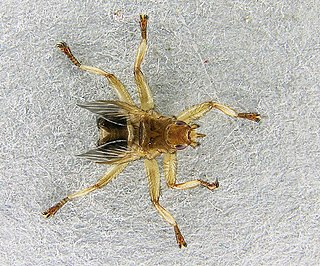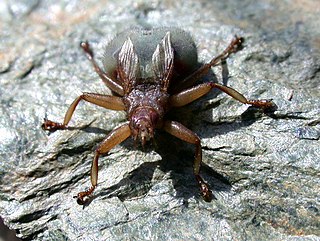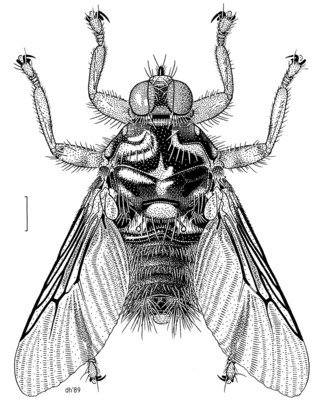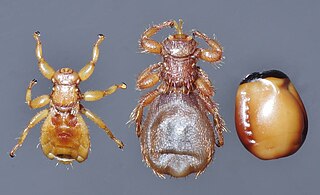
Flies are insects of the order Diptera, the name being derived from the Greek δι- di- "two", and πτερόν pteron "wing". Insects of this order use only a single pair of wings to fly, the hindwings having evolved into advanced mechanosensory organs known as halteres, which act as high-speed sensors of rotational movement and allow dipterans to perform advanced aerobatics. Diptera is a large order containing an estimated 1,000,000 species including horse-flies, crane flies, hoverflies and others, although only about 125,000 species have been described.

Hippoboscoidea is a superfamily of the Calyptratae. The flies in this superfamily are blood-feeding obligate parasites of their hosts. Four families are often placed here:

Horse-flies and deer flies are true flies in the family Tabanidae in the insect order Diptera. They are often large and agile in flight. Only female horseflies bite animals, and humans, to obtain blood. They prefer to fly in sunlight, avoiding dark and shady areas, and are inactive at night. They are found all over the world except for some islands and the polar regions. Both horse-flies and botflies (Oestridae) are sometimes referred to as gadflies.

Lutzomyia is a genus of phlebotomine sand flies consisting of nearly 400 species, at least 33 of which have medical importance as vectors of human disease. Species of the genus Lutzomyia are found only in the New World, distributed in southern areas of the Nearctic and throughout the Neotropical realm. Lutzomyia is one of the two genera of the subfamily Phlebotominae to transmit the Leishmania parasite, with the other being Phlebotomus, found only in the Old World. Lutzomyia sand flies also serve as vectors for the bacterial Carrion's disease and a number of arboviruses.

Phlebotomus is a genus of "sand flies" in the Diptera family Psychodidae. In the past, they have sometimes been considered to belong in a separate family, Phlebotomidae, but this alternative classification has not gained wide acceptance.

Hippoboscidae, the louse flies or keds, are obligate parasites of mammals and birds. In this family, the winged species can fly at least reasonably well, though others with vestigial or no wings are flightless and highly apomorphic. As usual in their superfamily Hippoboscoidea, most of the larval development takes place within the mother's body, and pupation occurs almost immediately.

Eristalis tenax, the common drone fly, is a common, migratory, cosmopolitan species of hover fly. It is the most widely distributed syrphid species in the world, and is known from all regions except the Antarctic. It has been introduced into North America and is widely established. It can be found in gardens and fields in Europe and Australia. It has also been found in the Himalayas.

Lipoptena cervi, the deer ked or deer fly, is a species of biting fly in the family of louse flies, Hippoboscidae. These flies are commonly encountered in temperate areas of Europe, Siberia, and northern China. They have been introduced to North America. They are parasites of elk, deer, and other deer family members, burrowing through the fur and sucking the blood of the host animals. Adults are only 5–7 mm (0.20–0.28 in) in length and brownish in colour. Their bodies are flat and elastic, making their removal difficult. L. cervi is a poor flier and can only fly for short distances. Once the insect reaches its target, it sheds its wings and starts burrowing through the fur.

Crataerina pallida, the swift lousefly, is a species of biting fly in the family of louse flies Hippoboscidae. These flies are commonly encountered in the nests of the common swift in Europe and Asia.

Crataerina is a genus of louse flies in the family Hippoboscidae. All are parasites of birds, feeding on the blood of various species of Apodidae (swifts) and Hirundinidae. The genus is sometimes spelled Craterina.
Lipoptena depressa, or the Western American deer ked, is a fly from the family Hippoboscidae and 1 of 3 flies within the genus Lipotena. They are blood-feeding parasites of the mule deer - Odocoileus hemionus in the western United States and Canada particularly in regions containing the Rocky Mountains.
Neolipoptena ferrisi, or the Pacific deer ked, is a species of fly from the family Hippoboscidae. They are blood-feeding parasites of the mule deer - Odocoileus hemionus, the white-tailed deer - Odocoileus virginianus & The Pronghorn - Antilocapra americana. They are found from British Columbia, Canada, to Baja California, Mexico.

Hippobosca equina, also known as the forest fly or New Forest fly, is a biting fly from the family Hippoboscidae. They are blood-feeding ectoparasites of primarily horses and other large mammals including cattle. It is a permanently fully winged fly, not shedding its wings on finding its host, as in some other Hippoboscidae. With its wings retained, it may thus fly away from its host to deposit its larvae. They are good fliers.

Melophagus ovinus, or the sheep ked, is a brown, hairy fly that resembles a tick. This wingless fly is about 4 to 6 mm long and has a small head; it is a fly from the family Hippoboscidae. They are blood-feeding parasites of sheep. The sheep ked feeds on the blood of its host by inserting its sharp mouthparts into capillaries beneath the skin. The legs of the sheep ked are very strong and tipped with claws. Sheep keds live their whole lives in the wool of sheep. They are most commonly found on the neck, shoulders, and underbelly of the host animal. Although they are often referred to as the “sheep tick”, sheep keds spend their entire lifecycle on their hosts, which is distinguishable from the characteristics of a true tick. Additionally, sheep keds have six legs, whereas true ticks have eight legs.
There are various disparate groups of wingless insects. Apterygota are a subclass of small, agile insects, distinguished from other insects by their lack of wings in the present and in their evolutionary history. They include Thysanura . Some species lacking wings are members of insect orders that generally do have wings. Some do not grow wings at all, having "lost" the possibility in the remote past. Some have reduced wings that are not useful for flying. Some develop wings but shed them after they are no longer useful. Other groups of insects may have castes with wings and castes without, such as ants. Ants have alate queens and males during the mating season and wingless workers, which allows for smaller workers and more populous colonies than comparable winged wasp species.
Hippobosca longipennis, the dog fly, louse fly, or blind fly, is a blood-feeding parasite mostly infesting carnivores. The species name "longipennis" means "long wings". Its bites can be painful and result in skin irritation, it is an intermediate host for the canine and hyaenid filarial parasite Dipetalonema dracunculoides, "and it may also be a biological or mechanical vector for other pathogens".
Diptera is an order of winged insects commonly known as flies. Diptera, which are one of the most successful groups of organisms on Earth, are very diverse biologically. None are truly marine but they occupy virtually every terrestrial niche. Many have co-evolved in association with plants and animals. The Diptera are a very significant group in the decomposition and degeneration of plant and animal matter, are instrumental in the breakdown and release of nutrients back into the soil, and whose larvae supplement the diet of higher agrarian organisms. They are also an important component in food chains.
Lutzomyia shannoni is a species of fly in the subfamily Phlebotominae, the phlebotomine sand flies. It is native to the Americas from the southeastern United States to northern Argentina. It has a disjunct distribution, and is only found in regions with suitable climates, habitat types, and host animals. It is well known as a vector of the vesicular stomatitis virus, which causes the disease vesicular stomatitis in animals, particularly livestock.

Many species of flies of the two-winged type, Order Diptera, such as mosquitoes, horse-flies, blow-flies and warble-flies, cause direct parasitic disease to domestic animals, and transmit organisms that cause diseases. These infestations and infections cause distress to companion animals, and in livestock industry the financial costs of these diseases are high. These problems occur wherever domestic animals are reared. This article provides an overview of parasitic flies from a veterinary perspective, with emphasis on the disease-causing relationships between these flies and their host animals. The article is organized following the taxonomic hierarchy of these flies in the phylum Arthropoda, order Insecta. Families and genera of dipteran flies are emphasized rather than many individual species. Disease caused by the feeding activity of the flies is described here under parasitic disease. Disease caused by small pathogenic organisms that pass from the flies to domestic animals is described here under transmitted organisms; prominent examples are provided from the many species.
Glossina fuscipes is a riverine fly species in the genus Glossina, which are commonly known as tsetse flies. Typically found in sub-Saharan Africa but with a small Arabian range, G. fuscipes is a regional vector of African trypanosomiasis, commonly known as sleeping sickness, that causes significant rates of morbidity and mortality among humans and livestock. Consequently, the species is among several being targeted by researchers for population control as a method for controlling the disease.











